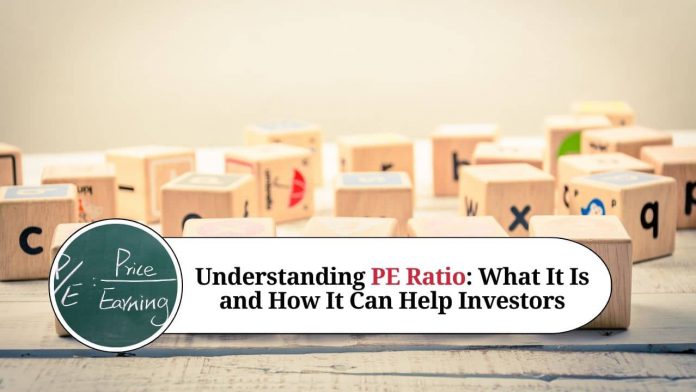As an investor, it’s essential to have a clear understanding of various metrics used in evaluating the financial performance of a company. One of the most commonly used metrics is the price-to-earnings (PE) ratio. In this article, we will define what the PE ratio is and explore how it can help investors make informed investment decisions.
What is the PE Ratio?
The PE ratio is a valuation metric that measures the current market price of a company’s stock relative to its earnings per share (EPS). It’s calculated by dividing the current market price per share by the EPS. For example, if a company’s current stock price is $50, and its EPS is $5, the PE ratio would be 10.
A high PE ratio may indicate that the company is expected to grow significantly in the future. Investors are willing to pay more for a stock with a high PE ratio because they expect the company’s earnings to increase in the future, which could lead to a higher stock price. Conversely, a low PE ratio may suggest that the company’s earnings are expected to decline, or the company may not have strong growth prospects.
How is the PE Ratio Used?
The PE ratio is a widely used tool for investors to assess the relative value of a company’s stock compared to its earnings. The ratio provides insight into how much investors are willing to pay for a company’s earnings. Typically, a company with a higher PE ratio suggests that investors expect higher earnings growth in the future.
Investors can use the PE ratio to compare a company’s current valuation to its historical valuation, its competitors, and the overall market. For example, if a company has a PE ratio of 20, and its historical PE ratio is 15, it may suggest that the company’s current stock price is overvalued. Similarly, if a company’s PE ratio is higher than its competitors, it could indicate that the market expects higher earnings growth from the company.
Limitations of the PE Ratio
While the PE ratio is a useful tool for evaluating a company’s stock price, it’s important to understand its limitations. The PE ratio is just one of many metrics used to evaluate a company’s financial performance, and it’s not a perfect indicator of a company’s future earnings potential.
The PE ratio can also be affected by non-recurring events, such as asset sales, one-time charges, or accounting adjustments. These one-time events can distort the earnings per share and lead to an inaccurate PE ratio.
It’s also important to remember that a high PE ratio does not always mean that a stock is overvalued, and a low PE ratio does not necessarily indicate that a stock is undervalued. The PE ratio is just one of many factors to consider when evaluating a company’s stock price.
Conclusion
The PE ratio is a widely used metric in the world of investing. It provides investors with a quick snapshot of how much the market is willing to pay for a company’s earnings. However, it’s important to remember that the PE ratio is just one tool in evaluating a company’s financial performance, and it should not be used in isolation. Investors should consider other metrics, such as a company’s revenue growth, cash flow, and debt levels when making investment decisions. By taking a holistic approach to invest, investors can make informed decisions and build a diversified portfolio that aligns with their investment goals.
Frequently Asked Questions:
Q:1 What is a PE ratio?
A: PE ratio stands for the Price-to-Earnings ratio, which is a financial metric used to measure the relative valuation of a company’s stock. It is calculated by dividing the current market price of a company’s stock by its earnings per share (EPS) over the past 12 months.
Q:2 What does a high PE ratio indicate?
A: A high PE ratio usually indicates that investors are willing to pay a premium for the company’s stock because they have high expectations for the company’s future growth potential. However, a high PE ratio may also indicate that the stock is overvalued and that the company’s current stock price is not supported by its current earnings.
Q:3 What does a low PE ratio indicate?
A: A low PE ratio may indicate that the company’s stock is undervalued and may represent a good investment opportunity. However, a low PE ratio may also indicate that investors have low expectations for the company’s future growth potential.
Q:4 How is the PE ratio calculated?
A: PE ratio is calculated by dividing the current market price of a company’s stock by its earnings per share (EPS) over the past 12 months. For example, if a company’s stock is trading at $50 per share and its EPS over the past 12 months is $5, its PE ratio would be 10.
Q:5 Is a high or low PE ratio better?
A: It depends on the context. A high PE ratio may indicate that the company has strong growth potential and may be a good investment opportunity. On the other hand, a low PE ratio may indicate that the company is undervalued and may represent a good investment opportunity. Ultimately, investors should consider other factors, such as the company’s financial health and growth prospects, before making an investment decision.
Q:6 Can the PE ratio be negative?
A: Technically, yes. If a company has a negative EPS over the past 12 months, then its PE ratio will also be negative. However, this is relatively rare and may indicate that the company is not profitable.
Q:7 How can the PE ratio be used in investment decision-making?
A: PE ratio can be used as a quick and easy way to assess the relative valuation of a company’s stock. However, it should be used in combination with other financial metrics, such as the company’s financial health, growth prospects, and industry trends. Investors should also consider their investment goals, risk tolerance, and other factors before making an investment decision based on the PE ratio.




















